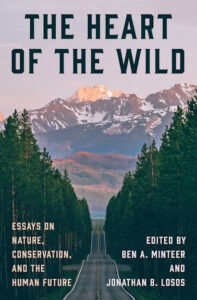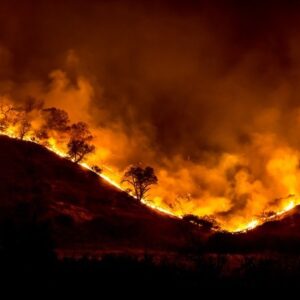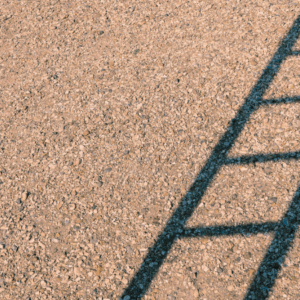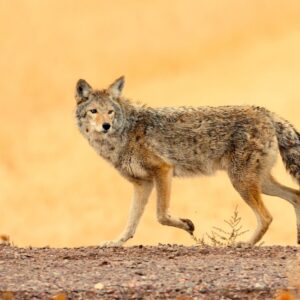
To Dream of Beauty: On the Possibility of Afrofuturism as a Solution to Climate Catastrophe
Christopher J. Schell Considers the Intersections of Systemic Racism and Systematic Destruction of the Environment
Biologists and environmentalists dedicated to studying the natural world may say that hope is a scarce resource of late. Human-driven shifts to the climate have increased the frequency and severity of extreme climatic events, including droughts, heat waves, flooding, and massive wildfires. Despite a growing recognition and awareness that humans are the primary contributors to the climate crisis, the slow and often tepid political response to counteract such extreme disasters is underwhelming.
As once-in-a-lifetime natural catastrophic events become more commonplace, we are becoming increasingly aware of how fragile ecosystem health is and how interdependent we are on the ecosystem services provided therein. Societies globally have a vested interest in functional ecosystems: provisioning services provide food, water, and other natural resources; regulating services balance temperature, precipitation, and other abiotic (e.g., water, air) factors; supporting services maintain nutrient cycling and sustain habitats; and cultural services enrich the educational, spiritual, and recreational values we gain from our natural environments.
Notably, ecosystems do not exist solely for human benefit—other nonhuman species also have a claim to a healthy and functioning ecosystem. Conserving ecosystem services—and by extension the natural capital that supports those services—is therefore both a global imperative and a just obligation.
Biodiversity is a central pillar to that natural capital, and unfortunately, human-driven alterations to natural landscapes are contributing to global biodiversity loss en masse. Biodiversity often serves as the conceptual and literal shield for ecosystem health and function: more intact links or nodes (i.e., species) within biological communities strengthen the integrity of any biological network. The removal of species deletes nodes within the network, and that makes it less robust and more porous, reducing species interactions that sustain the system.
For example, predators that are reliant on an extinct prey species may similarly go extinct. Likewise, the extinction of bees can lead to reductions in pollination services that hinder primary productivity of native plants. Hence, accumulating extinctions can precipitate trophic cascades that snowball to the collapse of biological communities, and with it, ecosystem health. This is especially troubling in the Anthropocene, where climatic and environmental changes can accelerate biodiversity loss, compromising environmental and societal resilience to change.
Afrofuturism at its core is a metaphysical and symbolic struggle to dream of beauty regardless of the current reality.
Society and the natural world are thus at a pivotal crossroads—continue the current status quo of exploitation and resource depletion or develop new frameworks that radically reimagine our relationship to the natural world. Make no mistake, it is an urgent priority that we collectively utilize and implement strategies that will directly address these interconnected calamities while simultaneously building resilience for a challenging environmental future. The damning recent Intergovernmental Panel on Climate Change (IPCC) Sixth Assessment Report illustrates the need for alacrity, as we are projected to blow past the key warming ceiling of 1.5 degrees Celsius with greenhouse gas emissions reaching their highest levels in decades.
In parallel, the Anthropocene epoch marks an unsettling start to the sixth mass extinction event on Earth, with an extraordinary loss of biodiversity not seen since the end of the age of dinosaurs. Technological and scientific advances in climate mitigation and biological conservation have propelled some measures to abate climate and environmental degradation, yet do not feel commensurate with the speed of climate-driven shifts. Moreover, the overwhelming feeling of fighting an unwinnable battle against the myriad societal, political, and economic forces in opposition of sustainable practices can exacerbate the fatigue and ecological grief that underpins detachment from producing solutions to the concurrent crises.
Rescuing ourselves from this negative social-ecological tailspin rests in the lessons of the African diaspora, and a fight that transcends space and time. Black communities globally have found hope, love, creativity, and strength in community. Such familial bonds exist across timelines with ancestors and living relatives as part of the larger tribe. The collective struggle to survive, find joy, and fight for justice despite overwhelmingly brutal opposition is an exemplar of resilience. Indeed, from slavery to genocide, Jim Crow segregation to apartheid, the intergenerational struggle for civil rights and equality provides a compelling framework to begin unpacking how we regain our bonds with nature.
Take for example the expression of Black joy, an expression emanating from pride in the identity and heritage of our African roots and one of the most beautiful forms of resilience. Events like the annual Black Joy Parade in downtown Oakland, California, showcase the emotive, vibrant, and diverse manifestations of such joy. The complex tapestry of experiences from the African diaspora are on full display—from the quad-skaters to the steppers, the drumline to the Black cowboys, educational empowerment to voting rights activists. The outfits, the art, and the hairstyles showcase our creativity, innovativeness, and beauty. The beats and rhythms provide a lens into the past and the future, while also celebrating the present. Dancing and smiles by participants and spectators alike signal an overdue release—from stress, grief, and the mental taxation of societal conformity, if even momentarily. Indeed, after a COVID-induced hiatus, the fifth annual Black Joy Parade returned stronger than ever, proudly taking center stage as the largest parade of its kind in California, and arguably in the United States
Such hope and joy persist despite the concomitant ecological and societal calamities shaping reality outside the boundaries of 17th Street and Broadway. In the last few years, the COVID-19 pandemic has disproportionately claimed the lives of Black and Latinx Americans. Concurrently, unjust murders, disproportionate incarceration rates, and state-sanctioned violence decreed on Black bodies has contributed to the chronic and intergenerational trauma experienced in Black communities. Further still, unjust zoning laws, gentrification, and displacement persistently uproot Black communities, while inequitable exposures to environmental and climate disamenities (e.g., poorer air and water quality, reduced green space) jeopardize health outcomes. Continued disinvestment in infrastructure, unequal access to natural capital, and the lack of economic opportunities widen the racial wealth gap, making it exceedingly difficult to survive as a Black person in America. Such patterns of disinvestment and devaluation are rampant on the global stage as well, as disease outbreaks, geopolitical conflicts, and climate-induced disasters receive a fraction of the attention that similar instances do in countries with less melanin.
The mere existence of Black joy is an act of defiance, one that customarily withstands the onslaught of destruction, disinvestment, dispossession, and death. In this way, Black joy serves as an elixir to rejuvenate communities and motivate the fight for the civil rights of all peoples. This radical inclusivity serves as the foundation of social and environmental justice movements, which stress the humanity of all peoples and the need for equitable access to healthy environments. Consequently, its infectious nature helps to envision what could be, serving as a catalyst for hope despite a grim and uncertain present. Key to understanding the persistence of Black joy against insurmountable odds is the fundamental belief that the spiritual energies of both our ancestors and descendants flows through us. This is typified in the widely known and recited statement in Black communities—“I am (We are) our ancestors’ wildest dreams.” The phrase originated from New Orleans visual artist, activist, and filmmaker Brandan Odums, and was popularized by influential Black figures like Ava Duvernay, who used the phrase in tribute to the ancestors of First Lady Michelle Obama. Melvinia Shields, who was born a slave in 1844, would be survived by five generations of progeny, ultimately leading to her great-great-great granddaughter—Michelle Obama—who would lead the very nation that sentenced Melvinia to life in bondage. In this example Duvernay and Obama honor our ancestors’ fight for survival as stolen people on stolen lands, while constantly working to improve current conditions to fully liberate future generations from systemic oppression. Black joy alone, however, is not an expansive enough discourse to fully articulate the rich complexity found within this example. Unpacking this complexity and its lessons for conserving biodiversity, and by extension our natural world, requires an all-encompassing framework.
Enter the guiding narrative, cultural aesthetic, and philosophical movement known as Afofuturism, which reimagines and explores a world where people of the African diaspora are fully liberated from the physical and cultural vestiges of colonial destruction and white supremacy. This philosophical freedom allows us to explore the intersections of Black culture, science, and technology to consider future timelines and realities that authentically place Black people at the center of global societies and advancement, rather than footnotes to global progress. Though the term was originally coined by cultural critic Mark Dery in his 1993 essay “Black to the Future,” artists, writers, and musicians were creating the emerging genre decades before it was codified. For instance, prolific writers such as Octavia Butler (Parable of the Sower, 1993) and Ralph Ellison (Invisible Man, 1989) have penned multiple Great American Novels that served as biting critiques of classist, racist, and sexist structures, while also highlighting the need to spotlight Black characters as protagonists rather than stereotyped caricatures. Prominent artists from Jean-Michel Basquiat to Kaylan F. Michael composed canvasses that collided African and African American aesthetics with various science-fiction motifs. Further, musicians from Parliament-Funkadelic to Herbie Hancock, and Outkast to Janelle Monáe brilliantly composed albums that blended rhythm and blues, hip-hop, jazz, and techno to birth new genres of psychedelic soul and funk that now are mainstays in American—and global—music culture.
Perhaps the most recent and popular example of Afrofuturism is Marvel’s Black Panther, a comic book turned movie franchise that envisions an entire nation—Wakanda—that exists as the most technologically advanced civilization on the planet. The character of Black Panther first appeared in the Fantastic Four #52 comic in July 1966, during the founding and rise of the Black Panther Party, a political organization headed by Bobby Seale and Huey P. Newton in Oakland, California, from 1966 to 1982 that stressed black liberation, sovereignty, and independence from white tyranny and brutality. At the time, Black Panther was the first and only Black Marvel superhero that had superpowers, and not surprisingly was lauded as a crowd favorite among Black Americans. To fully understand the gravity of this event, the Black Panther character arose in the heart of the civil rights era, shortly before Dr. Martin Luther King Jr. was assassinated and the Civil Rights Act of 1968 was signed. Fast forward to the late 2010s, and new prominent American novelists Ta-Nehisi Coates and Roxane Gay publish new graphic novel installments of Black Panther that further explore both the technological and scientific marvels of the Intergalactic Empire of Wakanda. Moreover, the 2018 Black Panther film reigns as one of the highest-grossing films ever created by the Marvel Cinematic Universe (MCU) and has sent reverberating shockwaves of pride and empowerment throughout Black communities globally. This is especially evident in Oakland, California, which has affectionately been given the nickname “Oakanda” after the release of the 2018 film.
So, then, how exactly is the Afrofuturism discourse applicable to narratives around the wild and nature? The examples highlighting Afrofuturism above certainly showcase extraordinary creativity and ingenuity, yes, but some may question how that is relevant to an increasingly dangerous collapse of the natural world. If our goal was to amplify connection among people and nature, including its wilder varieties, it would seem counterproductive to envision a more technologically advanced future as that bridge. In essence, how does Afrofuturism help to generate hope and solutions in our current reality? Revealing the relevant core lessons from Afrofuturism to the natural world requires that we transcend the pages, canvasses, musical arrangements, and film studios of the genre and interrogate the figures who created these reimagined worlds. Simply put: the works alone do not reveal the connection; Black people and our embodied realities are the connection. The effective coping and adaptive strategies used by Black communities to thrive despite centuries of violence and oppression are the key to building resilience in the natural world. The persistent fight for truth, liberation, justice, even in uncomfortable and challenging contexts, embodies the beautiful struggle—and represents the definitive thread between Afrofuturism praxis and conservation of the natural world.
Afrofuturism at its core is a metaphysical and symbolic struggle to dream of beauty regardless of the current reality. Black Americans have fought to hold the United States accountable to the ideals it espoused in the Declaration of Independence in 1776. As the recent 1619 Project: A New Origin Story written by Nikole Hannah-Jones illustrates, Black Americans have fought for a country that has repeatedly categorized them as inferior or less than human. As an insult to injury, American society has manipulated historical texts and records to eradicate historical narratives that provide the unabridged legacy of slavery in an alleged free society. Despite revisionist histories and the omission of key details, Black Americans have continued to fight for the civil rights of all peoples. Case in point: activists like the US House of Representatives John Lewis and author James Baldwin have consistently fought for the liberation of Black peoples, though they passed away before seeing the full gravity of their life’s work. Lewis, for instance, addressed the need to steadily work toward freedom, stating that “Freedom is not a state; it is an act….Freedom is the continuous action we all must take, and each generation must do its part to create an even more fair, more just society.” Baldwin, in his 1962 essay for the New York Times, writes that “not everything that is faced can be changed; but nothing can be changed until it is faced.” Both Baldwin and Lewis dedicated their lives to activism, which would have required some hope for a better future.
The parallels between confronting systemic racism and the climate crisis are revealing. Effectively dealing with the climate crisis and biodiversity loss requires that we acknowledge our role in driving both processes. Similarly, confronting and effectively eradicating systemic racism means reconciling and healing the past and current transgressions of our American ancestors. In both instances, the reticence to deal with the driving forces of white supremacy and capitalism have incapacitated and ill-equipped society to manage the co-occurring disasters at our doorstep. As Baldwin aptly exclaimed, “I imagine one of the reasons people cling to their hates so stubbornly is because they sense, once hate is gone, they will be forced to deal with pain.” Reconciling past ills and trauma is not an easy task, and yet it is necessary for society to progress beyond the past. Dealing with intergenerational and historical trauma tends to be especially difficult for Americans, as the fear of being labeled racist outweighs the desire to abolish racist systems. But like the interconnectedness embodied in Afrofuturism, our past colors our present, and if we let it, will dictate our future.
Research on the ecology of segregation appropriately highlights the profound impacts that past racially driven residential segregation can have on the ecology of urban ecosystems. Government-sponsored programs like redlining—an exclusionary and discriminatory housing policy established by the Home Owners’ Loan Corporation (HOLC)—categorized neighborhoods using color-coded maps to denote where American residents should live based on their race and wealth. Redlining was instituted from 1933 to 1968 for more than 230 US cities, and dictated patterns of investment, quality of municipal services, and green-space access. With the advent of the Fair Housing Act in 1968, which coincidentally was advanced by the actions of John Lewis and others, the system of redlining was abolished to make housing discrimination illegal. However, the vestiges of redlining are still felt on the ecological and health outcomes of our urban landscapes. Areas that were formerly redlined have greater air pollution, more intensified urban heat islands, reduced vegetation cover, and more frequent rates of ER visits and cancer. Though redlining policy was abolished in 1968—more than fifty years ago—cities are still experiencing the pernicious environmental disamenities that are linked to residential segregation from the 1930s to 1960s. Recent studies are also beginning to suggest that genetic diversity and species richness—two measures critical for measuring and sustaining biodiversity—are also being impacted by past racial inequities. The disparities even extend to how we perform our science. For instance, repeated evidence suggests community science platforms like iNaturalist and eBird have tremendous gaps in species sightings in redlined neighborhoods, highlighting how urban residents are less likely to make natural observations in neighborhoods perceived as “dangerous” or “threatening.” Coincidentally, societal biases are preventing us from doing our best science and making the necessary observations that help reconnect us to nature.
Emerging evidence on the legacy effects (i.e., the idea that past events and phenomena have long-lasting impacts on present social and ecological processes) driven by redlining shines a spotlight on the importance of interrogating past inequities as a driver of biological systems. Simultaneously, this and other social-ecological examples emphasize that the machinations of society impact biological systems. In other words, our actions toward each other—whether in the past or present—have pervasive consequences for all other organisms on this planet. The amplification of social and racial inequities can compromise ecological and climate integrity, making it an urgent priority to treat the root causes of societal ills as a requirement for building resilience to emerging climatic disasters. Yet again, undertones of Afrofuturism are applicable here, as the solution to addressing both ecological and societal ills requires time travel: the need to understand past events, their impact on the present, and potential projections into the future. This is not unlike the emerging field of climate futures, which provides a framework in which to envision the plausible structure of social and natural landscapes in response to several possible scenarios. Concurrently, our advancement as a species is principally hindered by our reticence to deal with the influence of past transgressions on our current and future ecological realities, which sabotages our ability to plan for and imagine any possible futures. If then, Afrofuturism and hope for a better future are the antidote to building resilient strategies that rescue the natural world, active ignorance of historical ills is the virus killing our link to the natural world.
Healing our connection to nature thus inherently means healing ourselves. To restore our connection to nature, it is a requirement to acknowledge that all human beings are part of nature. Doing so then advances our understanding of how we are connected to each other, as well as the other living and nonliving components of the planet. Perhaps as a sign of hope, discussions centered on the interconnectedness of people, the environment, and other living organisms has emerged repeatedly in the last few decades. For instance, the environmental justice (EJ) movement and culminating delegates to the First National People of Color Environmental Leadership Summit in October 1991 established the seventeen guiding principles that are critical to EJ praxis. The very first principle underscores the ecological unity with and interdependence of human civilization on nature. Moreover, the emergence of the One Health framework has gained considerable atention in organizing discourse on the interconnectedness of society, animals, and their shared environments. Ironically, the COVID-19 pandemic, which is a zoonotic pathogen, underscores how dependent our health, medical systems, and governance are on environmental health. In both activist (i.e., Environmental Justice) and academic (i.e., One Health) developments, undertones of Afrofuturism—hope for a more just future, community empowerment, and social-ecological unity—are pervasive throughout the DNA of each.
Still, considerable barriers exist for us implementing an Afrofuturist blueprint. Are we willing to be uncomfortable in the process, and divorce ourselves from the fear of pain to actually gain back our love of nature? Are we as a species willing to fight for all peoples’ right to the natural world, even if we personally are not privy to the end result? An Afrofuturist philosophy may argue that the fight for a truly liberated future is worth the struggle, regardless of whether it comes into existence in our lifetime. If we see the multi-pronged threats to the natural world as opportunities to fight back our own fears and connect as a species, then perhaps our connection to nature is simply obscured, rather than lost. Trauma is exceptionally adept at obscuring our vision, and thus, envisioning an equitable and interconnected future is the act of healing.
Tis is all to say that humanity’s collective journey back toward our love of nature is both exceptionally close and extraordinarily distant. Arguably, though a global majority of peoples acknowledge the significance of nature to humanity’s well-being—especially teachings emanating from communities of color, Indigenous peoples, and the Global South—the status quo sustained by global capitalist ideals is antithetical to substantive progress in conserving nature. Specifically, racial capitalism (i.e., the concept that race is central in forming social and labor hierarchies in capitalist systems) treats nature, the environment, and peoples of color as expendable commodities to be owned and controlled, rather than being a liberated force deserving of life free from privatization. Simply put, racial capitalism and nature cannot coexist. The destruction of nature for profit and the widening of wealth inequality is not sustainable, and reforms or modifications to this system will not yield different results. If we are to make direct recommendations for how we regain our connection to nature, the first step will necessarily need to be the dismantling of a capitalist system built on the tenets of resource extraction and human exploitation. Creating such a paradigm shift will require supplanting an insidious and resilient system: white supremacy.
Afrofuturism unchains our consciousness to dream of what could be, and thus think about the steps necessary to make those dreams a reality.
Afrofuturist narratives provide a compelling argument that suggests technological advancements through cultural ingenuity rather than maximizing economic profits is a possible future scenario, one of ecological coexistence rather than conquest. Creating space for various communities at local, regional, and global scales to weave in their traditional and experiential ways of knowing with conservation or climate solutions will pay untold dividends in shifting our viewpoint back toward nature. To give just one example: traditional Ghanaian structures use adobe mud blocks as the foundational building materials for homes, and the adobe serves as a brilliant architectural cooling agent in a tropical climate. Despite this ingenuity, British colonizers insisted on the use of cement blocks over the native adobe designs because they considered them more “sophisticated,” despite cement being vastly inefficient at providing cooler microclimates. Increased construction of cement homes meant that more resources needed to be imported into Ghana and more residents would start using air conditioners to cool their homes, two factors that would contribute to global climate change. Ghanaian designers and architects like Joe Osae-Addo are now using more inno-native designs that reintroduce Indigenous textiles, materials, and engineering that are locally adapted, creating living spaces that rest in equilibrium with, rather than in opposition to, the environment. An Afrofuturist lens would elevate these types of stories to illustrate that a future more connected to nature means giving reverence to the wisdom of our ancestors’ past innovations.
An Afrofuturist lens also provides us the space to think creatively about the future we want to see. Despite tremendous scientific advances in climate and environmental modeling projections, the future remains shrouded in uncertainty. It is hard to envision what future generations’ experiences with the natural world will be, and this is especially the case when those future communities will face markedly different environmental conditions. However, this does not mean that we do not currently have the ability to plan for that future. Whether through science or science fiction, Afrofuturism unchains our consciousness to dream of what could be, and thus think about the steps necessary to make those dreams a reality. Tis is not unlike creating a meticulous plan that partitions what feels like an insurmountable goal into achievable, bitesized deliverables that are less intimidating. Doing so allows us to lift ourselves out of climate “doomism” and creatively think about what is next, without knowing how that plan will ultimately turn out. This provides us a sense of agency in tackling a problem that can only be solved through collective planning and community engagement.
Finally, an Afrofuturist lens emphasizes that transformative societal and environmental change is simultaneously within our power and highly interconnected. The conservation and regeneration of the natural world is not simply maintaining genetic diversity, population abundance, and species interactions. These ecological metrics are similarly influenced by socioeconomic disparities, housing insecurity, aging infrastructure, and sociopolitical upheaval. Take, for instance, the recent cycles of droughts and fooding in the Bay Area, California. The summer’s end in 2022 witnessed a massive die-off of aquatic organisms that shocked the entire Bay Area community. Investigations concluded that discharged, treated wastewater was contributing substantial amounts of nutrients into waterways that led to the explosion of algal blooms. These blooms blocked out sunlight and consumed inordinate amounts of oxygen, suffocating marine life. A few months later, in January 2023, several consecutive atmospheric rivers pummeled California, leading to flooding and landslides that incapacitated residents. Aging stormwater infrastructure contributed to additional runoff of nutrient-rich water into those same waterways that were just hammered by the summer die-off. Unfortunately residents living in lower-income neighborhoods also experienced the brunt of these environmental burdens, with the greatest fooding occurring in the fats of the East Bay and the Bayview neighborhood in San Francisco.
This climate-driven one-two punch is but a single example amid a bevy of worldwide calamities, but these are not hopeless catastrophes. That’s the thing: we already have the research and solutions to mitigate or prevent future environmental collapses like those mentioned above. Increasing social equity, centering environmental and climate justice initiatives, embedding empathy into collective governance, and greatly improving our educational systems are just a few of the verified solutions that will bolster our resilience to impending environmental changes. Operationalizing an Afrofuturist lens is not always in service of creating new recommendations or restating validated recommendations that have repeatedly been called out by Black, Indigenous, and other community practitioners. Afrofuturism is also the hope that we can change—that we can authentically implement proposed solutions once we become fully liberated, emancipated, and decolonized. We can build resilience into our cities and towns, suburbs, and rural neighborhoods with the important start of understanding that we must change our relationship with nature by seeing how we are connected to nature through each other. Luckily the ancestors and elders from the diaspora and beyond have etched that path of compassion and empathy in our collective memory. We simply need to regain our power to hear those past lessons for a better future.
In 2018’s Black Panther, the late Chadwick Boseman’s character T’Challa states that “Wakanda will no longer watch from the shadows. We must find a way to look after one another, as if we were one single tribe.” The weight of that line underscores the need to unify all the world’s peoples, find commonality in our perspectives, and collectively work toward building resilience. Chadwick, too, fought for a considerable number of just causes before his passing, while his memory lives forever on screen as the emblem of Black pride and empowerment. In 2022, when the sequel to the critically acclaimed movie was released, Black Panther: Wakanda Forever beautifully captured how tremendous loss, grief, and trauma can obscure our ability to see our shared struggle in others. Shuri, played by Letitia Wright, exclaims at the movie’s conclusion that “vengeance has consumed us; we cannot let it consume our people.” In this line, Shuri and Namor hold the generational trauma of their peoples and find commonality in their shared experiences with structural violence and brutalism. Both these lines—from Black Panther and Wakanda Forever—are exemplars of the beautiful struggle: the constant fight to live in a world antithetical to your survival, yet the willingness to devote that life to the success and service of others. May we learn to disconnect from an ideology of individualism to think more communally, and wholly integrate Black perspectives and Black people into our future. If the lessons from our ancestors have taught us nothing else, the time to act is always now, even if we never see the fruits of our labor.
__________________________________

“Hope for the Wild in Afrofuturism” by Christopher J. Schell appears in The Heart of the Wild: Essays on Nature, Conservation, and the Human Future, edited by Ben A. Minteer and Jonathan B. Losos. Copyright © 2024. Available from Princeton University Press.
Christopher J. Schell
Dr. Christopher J. Schell is an urban ecologist, professor, father, and writer. Schell’s research in urban animal behavior, physiology, biodiversity, and human-wildlife interactions reveals the hidden stories of wildlife in our backyards and interrogates how systemic injustices within our cities profoundly impact us and the natural world. He is currently an Assistant Professor in the Department of Environmental Science, Policy, and Management at the University of California Berkeley, an Affiliate Faculty member of the Museum of Vertebrate Zoology, a Fellow and Board Member at the California Academy of Sciences, a National Geographic Explorer, and Grist Fixer. His research has been featured in National Geographic magazine, The Atlantic, The New York Times, Vox Explained, RadioLab, the BBC, various NPR productions, and recently showcased in an episode of the PBS show Human Footprint.












